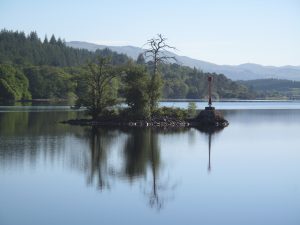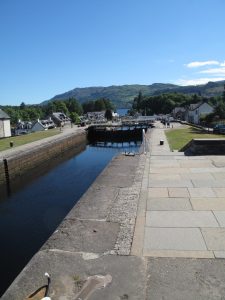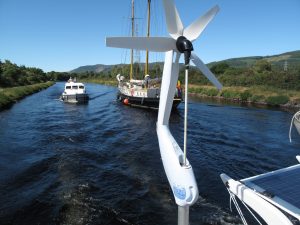It’s about 33 miles up Loch Linnhe to the entrance of the Caledonian Canal at Corpach, just north of Fort William.
Often described as a masterpiece of civil engineering, the canal is also a wonderful voyage through deep lochs and tree-lined canals all the way to Inverness and the North Sea.
Corpach sea loch was not very conspicuous for the entrance to a grand canal system, but one can understand why this spot was chosen. There is a very convenient anchorage nearby behind some small islands. We managed to transit this lock into the basin beyond in the afternoon, so spent a night alongside, ready to get moving at 0800 the next day, as there were a lot of boats passing through. Norwegian, Swedish, Danish boats heading west to the Hebrides, and some heading home.
The next morning we climbed up Neptune’s Staircase, a flight of 9 locks. With 3 on board it was fairly simple to have two line handlers ashore and the skipper motoring gently forward from one lock into the next – once we had learnt the method, and not before getting told to hurry up by one of the keepers (ex school teacher!)
This part of the canal system was cut into solid rock and was one of the most challenging sections for Telford and his teams, who started at each end and worked towards the summit at Laggan. The entire canal took 19 years to complete, was done with public money (partly as a scheme to employ Highlanders, who had to bring their own picks and shovels!), and was made largely by hand. They had three Boulton and Watt steam engines, the largest being an underwhelming 36HP, to pump out the locks while digging them. It was opened in 1822.
For us it cost just over 200 pounds to transit the whole canal, but for that you get access to pontoons, toilets and showers along the way, as well as a whole bunch of friendly lockkeepers and bridge-swingers.
The big lochs, Lochy and Loch Ness were a bit of a disapppointment as the wind was against us (it’s either up or down, so we looked enviously at the sailing boats running before the wind towards the west).
Loch Ness in particular has nowhere reasonable to anchor as it is very steep sided. We tried to stop in Urquhart Bay, next to the castle, but it was so unsatisfactory that we abandoned it and motored up to spend the night at Dochgarroch instead. A missed opportunity for them, as some mooring buoys just there would be bound to attract visitors to the Castle. It’s not run by the Waterways people, so all they can do is suggest.
The highlight of the canal has to be Loch Oich. This is a shallow loch in the middle , surrounded by woodland and very pretty.

Descending locks are much easier than ascending ones, as you don’t have to contend with the swirl of water entering the lock. At Fort Augustus there is a flight of 5 going down right through the town, with a swing bridge at the bottom. The lockkeepers warned us that the high temperatures had been causing the bridge to swell and jam, so we might be delayed. Probably they were more concerned about not being able to close it and thereby cutting off the main A82! What a problem to have – a heatwave in Scotland! (We were not much troubled by midges, having been told by someone rather over-dramatically that in hot dry conditions they just ‘explode’!!)
The last section of canal took us through to Muirtown, right by Inverness, and the final flight of locks into a large basin with the main canal marina. This has to be the cheapest marina going, as the first night was free (included with the canal pass) and the second cost a mere 5 Scottish pounds. This was due to the facilities being temporary as the main ones were being refurbished. Unfortunately it also meant the nearest place to wash the laundry was a half-hour walk into the city.
We met up with Mike and Helen for the last couple of days, and they were able to enjoy transiting the flight of locks down into Muirtown basin. After a couple of nights it was time to depart for the East coast, a whole new adventure and bound to be a contrast to what we had experienced so far.
The Clachnaharry sea lock is located at the end of a section of canal that sticks out into the Beauly Forth, all created by hand by those remarkable engineers. Originally of course the rationale was to enable the navy’s ships to get across Scotland easily, but the canal took so long to build that the war with Napoleon had long since ended when it was opened. We got a flavour of those times when we saw the TS Royalist coming down through the flight of locks into Muirtown basin. Spectacular!
Finally, we caught the tide and made our way east past Fort George, the last of the military strongholds in the Great Glen. The canal had been a delightful few days, a great place to enjoy some of the hottest weather in Scotland for 40 years.















